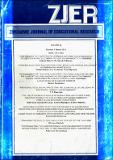| dc.contributor.author | Ndemo, Zakaria | |
| dc.contributor.author | Mtetwa, David J. | |
| dc.coverage.spatial | Zimbabwe. | en |
| dc.date.accessioned | 2016-02-02T16:18:47Z | |
| dc.date.available | 2016-02-02T16:18:47Z | |
| dc.date.issued | 2010-03 | |
| dc.identifier.citation | Ndemo, Z. and Mtetwa, D.J. (2010) Preferences of contexts for learning mathematics expressed by students in rural secondary school environments of Zimbabwe, Zimbabwe Journal of Educational Research, vol. 22, no.1, pp. 1-15. Harare: HRRC. | en |
| dc.identifier.issn | 1013-3445 | |
| dc.identifier.uri | https://opendocs.ids.ac.uk/opendocs/handle/20.500.12413/8858 | |
| dc.description | A ZJER journal article on how students could be assisted to appreciate Mathematics, as an academic subject, in the rural areas of the Zimbabwe educational system. | en |
| dc.description.abstract | The study aimed at identifying situations for learning Mathematics that could contribute to increasing student motivation for learning that subject in Zimbabwean rural secondary school settings. We asked how student preferences of contexts for learning Mathematics relates to schooling year, Form level and gender in rural secondary school environments. Judgmental and systematic sampling procedures were used to select 450 students from 5 out of about 30 rural secondary schools. Participants consisted of 225 boys and 225 girls all in the 13-17 age range and in their 8th, 9th, and 1ffh years of schooling. Data were collected by asking the ^students to express their interest levels in selected contexts for learning using a “Relevance of School Mathematics Education” (ROSME) instrument (Julie, 2005; 2006). Kendall's W mean ranks, medians, modes, clustered bar graphs, and Chi Square were used to describe the trends. The results indicate that learning situations related to science and technology were associated more with boys than with girls, while contexts for learning that have connotations of care-giving were associated more with girls in a rural secondary school setting. The results also suggest that generally higher levels of preferences of contexts for learning can be associated with Form 2 students— who are typically older than their Form 1 counterparts. While these results contradict a literature-based observation that interest with Mathematics diminishes overtime (i.e., with age), they probably show that the younger students could be carrying more restricted views of situations deemed to have potential for facilitating development of Mathematical concepts. | en |
| dc.language.iso | en | en |
| dc.publisher | Human Resource Research Centre (HRRC), University of Zimbabwe (UZ) | en |
| dc.rights.uri | http://creativecommons.org/licenses/by-nc-nd/3.0/ | en |
| dc.subject | Education | en |
| dc.subject | Rural Development | en |
| dc.subject | Science and Society | en |
| dc.title | Preferences of contexts for learning mathematics expressed by students in rural secondary school environments of Zimbabwe | en |
| dc.type | Article | en |
| dc.rights.holder | University of Zimbabwe (UZ) | en |


